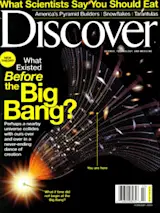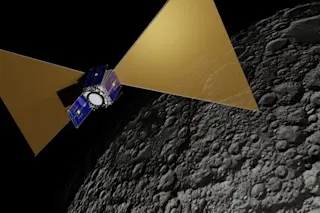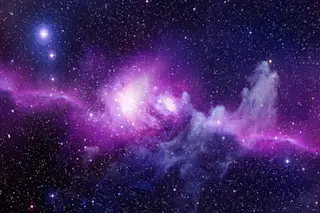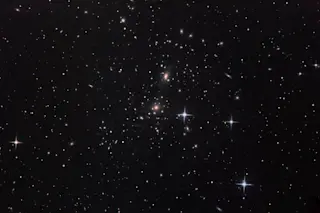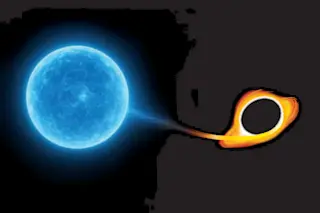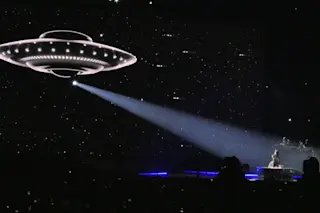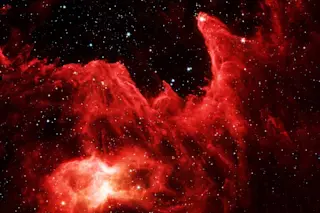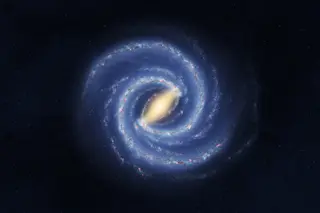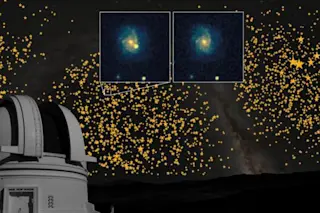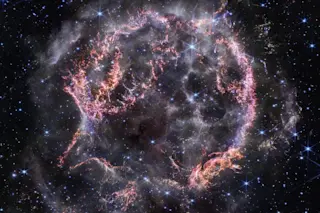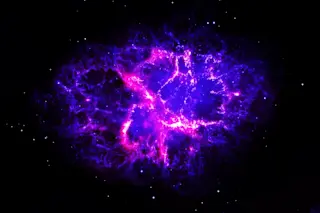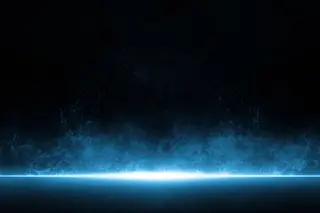The Catholic Church, which put Galileo under house arrest for daring to say that Earth orbits the sun, isn't known for easily accepting new scientific ideas. So it came as a surprise when Pope Pius XII declared his approval in 1951 of a brand new cosmological theory—the Big Bang. What entranced the pope was the very thing that initially made scientists wary: The theory says the universe had a beginning, and that both time and space leaped out of nothingness. It seemed to confirm the first few sentences of Genesis.
Eventually, astrophysicists followed the pope's lead, as evidence for the Big Bang became too powerful to ignore. They accepted the notion that the entire observable universe —100 billion galaxies, each stuffed with 100 billion stars, stretching out more than 10 billion light-years in all directions — was once squashed into a space far smaller than a single electron. They bought the idea that the cosmos burst into existence precisely 13.7 billion years ago and has been expanding ever since. But even now, many astrophysicists are still uncomfortable with the implication that the Big Bang marked the beginning of time itself. And the theory has yet to yield a satisfactory answer to a key question: What made the Big Bang go bang?
Cosmologists Paul Steinhardt and Neil Turok have a radical idea that could wipe away these mysteries. They theorize that the cosmos was never compacted into a single point and did not spring forth in a violent instant. Instead, the universe as we know it is a small cross section of a much grander universe whose true magnitude is hidden in dimensions we cannot perceive. What we think of as the Big Bang, they contend, was the result of a collision between our three-dimensional world and another three-dimensional world less than the width of a proton away from ours—right next to us, and yet displaced in a way that renders it invisible. Moreover, they say the Big Bang is just the latest in a cycle of cosmic collisions stretching infinitely into the past and into the future. Each collision creates the universe anew. The 13.7-billion-year history of our cosmos is just a moment in this endless expanse of time.
The hidden dimensions and colliding worlds in the new model are an outgrowth of superstring theory, an increasingly popular concept in fundamental physics. Scientists currently rely on two mutually incompatible theories—relativity and quantum mechanics—to describe the most massive objects in the universe on the one hand and subatomic particles on the other. For nearly a century, theorists have attempted to come up with a single model and a single set of equations that melds the two views of physics. Superstring theory is an evolving attempt to do just that: explain matter, energy, space-time, and the basic forces of nature in one framework.
String theory is hellishly complex. In order to make it work, theorists have to assume that space isn't merely three-dimensional, the way it appears to our puny human senses, but rather that it has up to 10 spatial dimensions. Just as a bedsheet hanging on a clothesline appears to be a two-dimensional object hanging in a three-dimensional world, all of space-time would be suspended in a higher-order space. In keeping with this two-dimensional analogy, string theorists describe our observable universe as a membrane —"brane" for short — flapping in the breezes of the actual 10-dimensional cosmos.
Physicists are just beginning to poke and prod at the big implications of superstring theory. That's what Burt Ovrut of the University of Pennsylvania was doing during a 1998 cosmology conference at the Newton Institute of Mathematical Sciences in Cambridge, England. He asked: If we live on a brane that's wafting through multidimensional space, why shouldn't there be other such branes floating around out there? Nothing in the theory ruled out this possibility. And if other branes exist, they could interact. It would be fascinating, Ovrut proposed during his talk, to consider what might happen if they did.
The idea intrigued Steinhardt, a professor at Princeton University who was sitting in the audience. If the interaction between branes was a collision, it would trigger a fantastically powerful reaction, Steinhardt guessed, given the immense amounts of matter and energy in each one. The crash would release so much energy, in fact, that it might be comparable to another energy release he was already quite familiar with: the Big Bang.
Meanwhile, Turok, a professor at Cambridge University, was sitting in the same audience having similar thoughts. After the lecture both men approached Ovrut to discuss their ideas. "It was clear that a collision of branes would be a dramatic event," Turok says. "People had talked about it in a mathematical way before, but nobody had thought of it as a real, physical process."
Steinhardt, Turok, and Ovrut, along with Steinhardt's graduate student Justin Khoury, decided to see what implications colliding branes might have for cosmology. They weren't driven by idle curiosity alone. Steinhardt, in particular, had been growing increasingly disenchanted with the conventional Big Bang model. The problem wasn't just that the theory required that time and space have a beginning but also that the more cosmologists tried to refine their model, the messier it seemed.
The original Big Bang model was simple: a hot dense knot of energy burst outward, congealed into matter, and kept expanding. But by the 1980s, astrophysicists had embraced a more complex elaboration of the Big Bang known as inflation.
Ironically, one of the theorists who developed this idea was Steinhardt. Inflation theory postulates that in the first hundred-millionth of a billionth of a billionth of a billionth of a second of its life, the universe expanded as though it were turbocharged, swelling much faster than the speed of light, before settling down to a more sedate rate of growth.
The only way that could have happened is if there had been some incredible energy source pervading the newborn cosmos and blowing it apart. We don't see anything like that in the universe today, however, so cosmologists had to assume the potent energy field existed for only a fraction of a second after the Big Bang and then vanished.
Conjuring up new, unknown energy fields goes against both common sense and one of the most cherished scientific doctrines. A principle known as Occam's razor says the simplest possible explanation for natural phenomena is usually right. Perhaps the best-known example is the Earth-centered cosmology of Ptolemy, which dominated Western science for 1,000 years.
When Ptolemaic theorists discovered that the planets did not appear to be moving in a simple pattern around Earth, they added epicycles — tiny circular movements on top of the grand orbital circles. Closer examination showed that this didn't quite explain observations either, so the theorists added epicycles on top of epicycles until the model did work. The final result was also very complex. Then Copernicus came along with the idea of a sun-centered cosmology, and Johannes Kepler realized that planets actually move in ellipses. Suddenly, planetary motions made sense without the complexity of epicycles, and the old theory was dropped.
Inflation seemed like a necessary complexity. Without it, the universe would look very different—for instance, galaxies on one side of the universe would be distributed differently from galaxies on the other side, which they don't appear to be. As inflation caught on, however, some cosmologists grumbled about epicycles. Then the Big Bang got even more complicated.
Starting about five years ago, astronomers measuring the expansion rate of the universe discovered that billions of years after the Big Bang—long after inflation had died out—cosmic expansion started speeding up again. Theorists invoked another unknown energy field, called dark energy, to account for that cosmic acceleration. "This wasn't really predicted at all," says Steinhardt. "We can fit it into the model, but we don't know what this so-called dark energy is. The standard model is definitely becoming more encumbered with time. It may still be valid, but the fact that we have to keep adding things is a bad sign."
Astronomical evidence clearly indicates that the observable universe has been expanding for the past 13.7 billion years. In the inflationary Big Bang model, the universe was hot and dense at the outset, and then immediately went through a period of hyperexpansion. Steinhardt and his colleagues considered a very different possibility: What if the universe actually started out cool and vacuous?
If that were the case, the idea of branes colliding in a hidden dimension might provide a simpler explanation for the ongoing expansion. To find out whether the idea made sense, the pair took on the daunting task of mastering the equations of superstring theory and applying them to their theory.
For simplicity, the researchers assumed that the branes were flat and parallel to each other. They also assumed that the branes contained no matter. That didn't mean the branes were voids: Quantum theory asserts that even the total vacuum of empty space is seething with "virtual" subatomic particles that constantly wink in and out of existence. In aggregate, these virtual particles add up to a huge amount of latent energy—which, according to Einstein's theory of special relativity, is equivalent to an astounding amount of mass. So a crash between two empty branes would still be a collision of gigantic proportions.
That's exactly what the universe looked like before the first stars ignited and the first galaxies formed. We know that because the Wilkinson Microwave Anisotropy Probe (WMAP), launched in 2001, recently revealed the pattern of hot and cold spots in the heat left over from the earliest days of the universe. In the Big Bang/inflation model, the hot spots are generated by quantum noise that is magnified by the inflationary energy field. "Much to our surprise, after doing these enormous, intricate calculations, we found out colliding branes would produce exactly the same pattern of temperature fluctuations," says Turok.
"It seemed almost miraculous to us that it turned out this way," says Steinhardt. The new idea was dubbed the ekpyrotic universe. Ekpyrosis means conflagration in Greek and refers to an ancient Stoic cosmological model in which the universe is caught in an eternal cycle of fiery birth, cooling, and rebirth.
The research team subsequently turned its attention to what would happen in the branes after a collision. Calculations suggested that the crash would generate a universe-wide fireball of pure energy within each brane. That blast would drive the two branes apart again. Then, as the fireball suffusing our brane began to cool, its underlying energy would undergo a phase transition, like water freezing into ice. This transition would unleash a force that would make the universe start to expand. The hot spots of the fireball would congeal into clumps of matter that would eventually become clusters of galaxies. The cold spots would become the empty voids that lie between the clusters.
This theorizing agrees with what we can see in our universe now. The ekpyrotic model leads to a scenario a lot like the fireball of the Big Bang, but there is no episode of inflation. From the outset, the cosmos experienced just one force that accelerated the expansion. That force is still at work today, which means that instead of coasting to a stop, the universe is expanding faster today than it was a billion years ago and will be expanding faster a billion years from now. In short, that one force would also explain the enigmatic force that astronomers have recently named dark energy.
Further calculations by Steinhardt and Turok suggest we're at the beginning of a very long process that will eventually result in what appears to be an empty universe. Trillions of years from now, matter will be so widely spread out that its average density will be much less than a single electron per quadrillion cubic light-years of space. That's so close to zero density that there's no meaningful difference.
Again, this scenario echoes the predictions of conventional Big Bang cosmology, except that in the model proposed by Steinhardt and Turok, the story does not end there. In the far future, another three-dimensional world still lurks nearby, similarly emptied out after its encounter with ours, invisible and imperceptible to us. Although they bounced apart after the collision, the two branes will exert a force on each other that's analogous to gravity, and they will ultimately meet in another crash, triggering another Big Bang. The cycle of such collisions would be eternal.
"Cyclic-universe models were popular in the 1920s and '30s," Steinhardt says. "But they were based on the idea of a Big Bang followed by a Big Crunch followed by another Big Bang." In these models, the same matter is endlessly recycled, so the entropy of the universe—its tendency toward disorder over time—increases from one cycle to the next. "The result is that each subsequent cycle gets longer," Steinhardt says. "And if you go back into the past, each cycle gets shorter. Ultimately, you still have to have a beginning." In principle, scientists shouldn't care. In practice, most have a very human tendency to abhor the idea of a beginning to time. And most find the prospect of a universe that will end someday to be rather grim. In this new cyclic model, the universe starts essentially empty each time. That means virtually no matter gets recycled. So entropy doesn't increase, and there is no beginning or end to time.
The model works so well that one might expect cosmologists to embrace it wholeheartedly. Actually, the reception has been lukewarm. One reason is that at the moment of collision, the extra dimension separating the two branes goes from vanishingly small to literally zero. That creates what physicists call a singularity, a point at which the laws of physics break down. Although superstring theory might help explain what happens in a singularity, it hasn't done so yet. "The problem is very difficult," Turok admits.
That, say some physicists, is an understatement. "I don't think Paul and Neil come close to proving their case," says Alan Guth, a cosmologist at MIT who is a founding father of inflation theory. "But their ideas are certainly worth looking at." Nathan Seiberg, a string theorist at the Institute for Advanced Study in Princeton, is also cautious. "I don't know whether their model is right or wrong," he says.
Joel Primack, a physicist and cosmologist at the University of California at Santa Cruz, isn't even all that interested in whether it's right or wrong. "I think it's silly to make much of a production about this stuff," he says. "I'd much rather spend my time working on the really important questions observational cosmology has been handing us about dark matter and dark energy. The ideas in these papers are essentially untestable."
Steinhardt and Turok respond that their theory could gain credence from LISA, a proposed space probe that would look for gravity waves from the early universe. Gravity waves are ripples in the fabric of space-time that were predicted by Albert Einstein. So far, they are theoretical. But by 2020, the LISA experiment—pairs of free-flying satellites that would move apart and together with each passing wave—could either find confirming evidence of inflation or find nothing and thus tip the scales toward ekpyrosis. Inflation theory posits that the entire mass of the universe accelerated to many times the speed of light in a fraction of a second and should have set the entire cosmos ringing with gravity waves. Ekpyrosis, by contrast, which involves a very slow collision between universes, wouldn't generate observable waves. "If we're right," says Steinhardt, "it will be terrifically exciting. If we turn out to be wrong, that'll be disappointing, of course, but it's still important to challenge inflation with alternate theories so we can see how robust it really is."
David Spergel, a Princeton astrophysicist and a member of the WMAP satellite research team, agrees. "Cosmology has to be tied in with superstring theory sooner or later," he says. "There are several ideas out there competing with inflation, and they may all turn out to be wrong. But I'd say this one has the best chance of being right." If it is, we need to rethink our place in the universe—in fact, we need to rethink the universe itself. In the ekpyrotic view of reality, everything that astronomers have ever observed is just a speck within the higher dimensions, and all of history since the Big Bang is but an instant in the infinity of time. This view of creation is far grander than the universe of traditional cosmology or the universe of the Bible.
So far, the pope hasn't weighed in.


